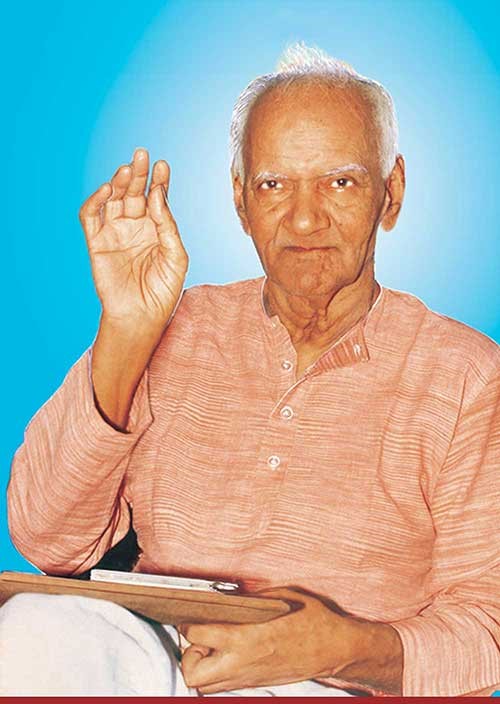Gāyatrī Mahāvijñāna – 03
The Manifestation of Gāyatrī from the Effulgence of Brahman
Everything in existence has originated from the eternal Supreme Reality (Brahman). When the thought of creation arose in the divine consciousness, a spontaneous effulgence emerged, which was called Shakti (Divine Power). Through this Shakti, two types of creation were manifested:
- Jada Sṛṣṭi (Inert Creation) – governed by Prakṛti (Nature).
- Caitanya Sṛṣṭi (Conscious Creation) – governed by Sāvitrī (Divine Intelligence).
Symbolism of Creation in the Purāṇas
The Purāṇas describe that at the dawn of creation, a lotus emerged from the navel of the Supreme Being. From this lotus, Brahmā appeared, and from him, Sāvitrī was manifested. Through the union of Sāvitrī and Brahmā, the four Vedas were born, and from these, all forms of knowledge emerged. Thereafter, Brahmā created the five-elemental universe.
This allegorical narrative holds deep mystical significance. The Supreme Brahman, which is formless, beyond attributes, and untouched by duality, manifested a divine impulse (Sphuraṇa) within itself. This impulse originated in its central essence (Nābhi – the navel) and bloomed like a lotus, symbolizing the expansion of divine consciousness.
The Śruti scriptures describe that at the beginning of creation, Brahman desired to become many (Eko’ham Bahu Syām – “I am One, let Me become many”). This desire took the form of a subtle impulse, which emerged as a lotus bud and then blossomed into full radiance.
The Threefold Power of Creation
On this lotus, Brahmā appeared as the first expression of the Divine Trinity (Brahmā, Viṣṇu, Maheśa). Later, these three deities assumed distinct cosmic roles of creation, sustenance, and dissolution. In the initial stage, however, only Brahmā appeared, as the act of creation was the first necessity.
Brahmā’s work commenced with the creation of two realms:
- Caitanya Sṛṣṭi (Conscious Creation): This encompasses all sentient beings endowed with will, awareness, and ego. The collective vital energy within the cosmos is called Prāṇa, which animates all living entities. This Prāṇa (vital force) further divides into three aspects:
- Vichāra (Thoughts).
- Saṅkalpa (Intentions).
- Bhāva (Emotions).
- Jada Sṛṣṭi (Inert Creation): Brahmā then created the five elements (Pañca Mahābhūtas)—Earth, Water, Fire, Air, and Space. All physical forms in the universe, from mountains and rivers to the human body, are composed of these fundamental elements.
While conscious creation expresses itself through will, intent, and movement, inert creation manifests through atomic structures and dynamic physical processes. Both realms are governed by two fundamental forces:
- Saṅkalpa Śakti (Power of Intent).
- Paramāṇu Śakti (Power of Atoms).
Among these, Saṅkalpa Śakti (Conscious Willpower) was required first, as without consciousness, the atomic realm would serve no purpose. Thus, Brahmā first manifested consciousness, the divine impulse of knowledge, which in Purāṇic symbolism is depicted as the revelation of the Vedas.
The Birth of Gāyatrī: The Divine Knowledge of Creation
The Purāṇas further describe that from Brahmā’s being, a divine maiden of extraordinary beauty emerged. Since she was born from his own essence, she was considered his daughter. With her assistance, he continued the process of universal creation. However, upon witnessing her radiance and beauty, Brahmā became enchanted and sought union with her, from which the five-elemental material universe emerged.
Many fail to grasp the esoteric nature of this symbolic Purāṇic allegory and mistakenly interpret it in a mundane or irreverent manner. However, Brahmā is not a human entity, nor is the power that emerged from him a literal daughter or spouse. This allegory poetically illustrates a fundamental truth of cosmic creation in an artistic and metaphorical style.
The Dual Role of Gāyatrī and Sāvitrī
Brahmā, as the creative power of the Supreme, has two aspects of energy:
- Saṅkalpa Śakti (Power of Divine Will): This represents pure consciousness, which, being subtle and luminous, is called Brahmā’s daughter.
- Paramāṇu Śakti (Power of Matter): This represents the gross, material energy, which, being active and transformative, is called Brahmā’s spouse.
Thus, in mystical terms, Gāyatrī and Sāvitrī are referred to as Brahmā’s daughter and spouse, respectively.
- Gāyatrī represents divine wisdom and spiritual enlightenment.
- Sāvitrī governs the dynamic force of life and the sustaining power of creation.
In essence, the Vedas, the universal consciousness, and the material world all emerge from the eternal Brahman through the power of Gāyatrī and Sāvitrī.
Gāyatrī Mahāvijñāna – 03 Read More »

